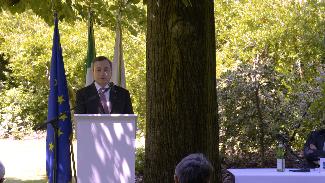 01
Giugno
2021
01
Giugno
2021
Mario Draghi meets the Italian ceramic industry
The full version of the event with Prime Minister Mario Draghi can be viewed here
Italy’s Prime Minister Mario Draghi visited the Sassuolo ceramic district today. He was welcomed to Fiorano Modenese by the President of the Emilia-Romagna Regional Government Stefano Bonaccini and Confindustria Ceramica Chairman Giovanni Savorani, together with civil, military and religious authorities. To mark the occasion, Mr Draghi visited the state-of-the-art production facility of a local ceramic company which exemplifies the level of excellence and sustainability achieved by the entire Italian ceramic industry, a sector that has invested a total of 2.2 billion euros in technological innovation over the last five years.
The association’s chairman Giovanni Savorani provided an overview of the ceramic sector. “The industry generated 4.4 billion euros from exports in 2020 and made up for last year’s decline in the first quarter of 2021. The sector employs 20,000 people directly and creates work for a similar number across the supply chain, with 90% of national production concentrated in the Emilia Romagna region. In the last twenty years, Italian ceramic tile production has fallen by 200 million square metres, an equivalent figure to the increase in production of the Spanish industry, our main competitor in international markets.” There is no single factor behind this decline, explained Mr Savorani, but rather a series of concomitant causes that have held back the competitiveness of Italian companies. The most significant of these is the high cost of labour – due to excessively high taxation of both companies and workers – which is 40% lower in Spain, as well as the lack of infrastructure in a district that handles 18 million tonnes of raw materials and finished products every year. “The Campogalliano-Sassuolo motorway link road would make it possible to further optimise rail transport, which already accounts for 23% of total traffic compared to a national average of 9%.” Mr Savorani also called for a review of the European ETS guidelines to allow the ceramic industry to recoup its indirect energy costs and eliminate competitive distortion effects such as the financial speculation that has driven up the cost per tonne of CO2 from 19 euros in November to today’s figure of 54 euros. To conclude, Mr Savorani reminded the audience of the September edition of Cersaie, “the first international exhibition devoted to architecture and design to be held in Italy since the reopening, where 95% of the available spaces have already been booked”.
The President of the Emilia Romagna Regional Government, Stefano Bonaccini, began by praising the excellence of the region’s healthcare system. “More than a million people will soon have completed the vaccination process, and by the summer we expect to have vaccinated everyone who wants the vaccine, not least because the public vaccination hubs will soon be complemented by company centres,” he said. “Ours is a productive, hard-working region where research, innovation, manufacturing and sustainability go hand in hand. By the end of next year, regional GDP will surpass pre-Covid levels. As was the case after the devastating earthquake of 2012, we are ready to restart today, united in our determination to fully support the national recovery and resilience plan (NRRP).” Mr Bonaccini recalled the excellence of the Bologna Big Data Technopole, which will make Emilia Romagna the largest European data valley with 83% of national and 21% of EU computing capacity. He concluded by confirming the priority of unblocking the infrastructure work which will link the district directly with Europe and which has been stalled for too long despite having been approved and financed.
In his first visit after the pandemic, Prime Minister Mario Draghi was keen to emphasise the area’s spirit of enthusiasm and enterprise. “Italian ceramics remains a centre of excellence within our manufacturing landscape, as confirmed by the figures for international trade and for the first quarter,” remarked Draghi. “Your sector has always invested at levels well above the national average and this is a sign of confidence in the future. The government’s job is to create a climate that is favourable and not hostile to your business initiatives so as to nurture growth, whether in terms of infrastructure, training or cutting red tape. We are now embarking on a new phase of reconstruction in which we must create a fairer and more modern country capable of achieving lasting growth, unlike that of the past 20 years. The Italian manufacturing districts are the real drivers of the recovery. We need a united Italy that will grow and believe in the future.” Mr Draghi then outlined the initial funding provided by the government, including 30 billion euros for the digitalisation of companies, 18 billion euros for the Transition 4.0 programme and 12 billion euros to support companies’ R&D investments. The technical college system will also be expanded to enable apprenticeships to meet the needs of businesses.
“The 35 billion euros available for the renovation of public and private buildings will have a major impact on the sector,” the Prime Minister noted.
Finally, Mr Draghi recalled the Simplification Decree, approved by the Cabinet last week with the aim of making life easier for businesses and citizens by reducing uncertainties and speeding up bureaucratic procedures.